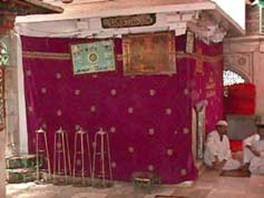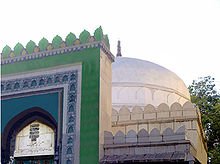|
One can reach the building; it starts from Dargah Bazar to west along the boundary wall of Dargah Sharif. After crossing Tripoli Darwaza, there is Mohalla Inderkot. At a short distance from Inderkot this mosque is located on right hand side.
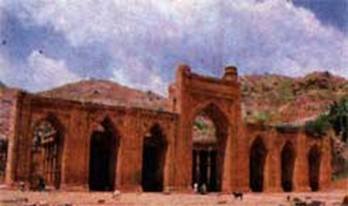
--------------------------------------------------------------------------------
TARAGARH FORT:
It is a grand fort, located on a steep hill in south of Dargah Sharif, The height of the hill is 800 ft. During the region of Rai Pithora, it was a famous and a strong fort and was considered it cannot be conquered. But Sultan Shahabuddin Gori conquered it without any difficulty and appointed Syed Meeran Husain (R.A.) as the Garrison Commander (Qiledaar). Night Attack on Taragarh.
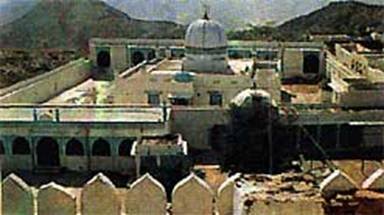
--------------------------------------------------------------------------------
ANA SAGAR :
Ana Sagar is a beautiful lake in the heart of the city. There is a high hill on the south western side of Ana Sagar, known as Sada Bahar hill, On the South western corner of the hill is a small cave having a Tomb on the Top of it. Khwaja Gharib Nawaz (R.A.) took seclusion here for the first time. He used to sit on the stone-bench lying inside the Chillah Sharif and engaged himself in Contemplation.
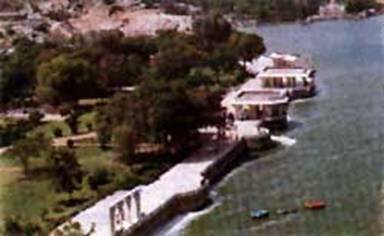
On the North-Eastern side of Sada Bahar is located the Chillah of Hazrat Khwaja Qutubuddin Bakhtiar kaki (R.A.). It is the place where Hazrat engaged himself in prayers when in Ajmer
--------------------------------------------------------------------------------
CHILLA BADE PIR SAHIB:
On the top of a hill in the South of Dargah Sharif is a green colored tomb. It is said that a brick of holy Mazar of Hazrat Piran-e-Pir Dastagir Sheikh Abdul Kaqir Zilani (R.A.) is buried. That is why the place is famous as Chillah Bare Pir Sahib, otherwise Hazrat Piran Pir (R.A) never came to India.
--------------------------------------------------------------------------------
NIZAM GATE:
Mir Osman Ali Khan, The Nizam of Hyderabad Deccan, erected the main gate of the Dargah Sharif in 1911. Upstairs small drums beat, during the day and night at an appointed hour. A view of Dargah Bazaar can be seen from the top of the gate.
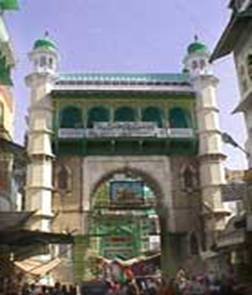
--------------------------------------------------------------------------------
SHAHJAHANI GATE:
Immediately following the Nizam gate is the Shahjahani gate erected by Emperor Shahjahan. Before the construction of the Nizam Gate this used to be the main gate. Above the gate the Kalma Sharif is inscribed in a beautiful style. The doors are made of fine timber covered with silver-plated metal. In the building above the gate there are two huge beating drums.
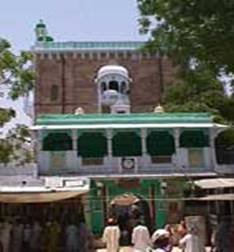
--------------------------------------------------------------------------------
AKBARI MASJID:
Between Shahjahani gate and Buland Darwaza on the right hand side is situated the Akbari Mosque erected by Akbar with red sand stone, A religious institution (madarsa) has been located in this mosque called Darul-uloom.

--------------------------------------------------------------------------------
BULAND DARWAZA:
Buland Darwaza is a high entrance that was erected by Mahmood Khilji or one of his successors. Before the commencement of Urs Sharif a flag is hosted on top of this gate with grand ceremony on the 25th Jamadiulsaani for ushering the 'Urs' of Khwaja Saheb, which starts from 1st of Rajab (The 7th month of lunar Calendar).
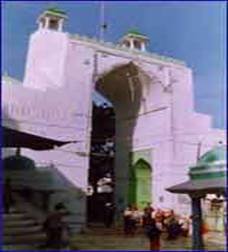
--------------------------------------------------------------------------------
LANGAR KHANA:
Langar Khana is a free public kitchen where about 5 mounds of barley meal is cooked twice a day and distributed to the poor without any discrimination.
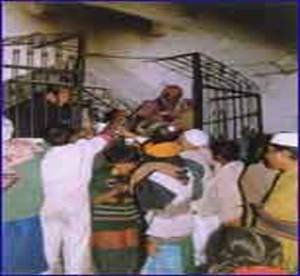
--------------------------------------------------------------------------------
VICTORIA TANK :
In the memory of Queen Mary's visit to the Shrine, the roof of the tank was constructed by the British Government for the convenience of the worshippers.

--------------------------------------------------------------------------------
IBADAT KHANA (PLACE OF RECITATION) :

The two enclosures situated just outside the southern gate of the Shrine adjacent to the tomb of Bibi-Hafiz Jamal bear the graves of some of the early descendants. The Holy Quran is recited by the devotees especially by ladies in these enclosures and the reward of this virtuous action is offered to the noble soul of Hazrat Khwaja Saheb.
--------------------------------------------------------------------------------
JANNATI DARWAZA :
This gate too is situated on the western side of the Shrine adjacent to the tomb of Gaite- Ara. The doors of the gate are covered with silver metal. It is opened only four times during the year, viz twice on Eids (for one day) during the annual Urs (for six days) and on the 6th of Shawwal, the Urs of Khwaja Sahib’s Peer-o-Murshid of Hazrat Khwaja Garib Nawaz R.A..

--------------------------------------------------------------------------------
AULIA MASJID:
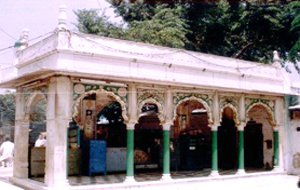
The place where Khwaja Sahib stayed for a few days, when he came to Ajmer for the first time, has now been turned into a mosque called Aulia Masjid. It is made of white marble. Devotees use it only for recitation of Holy Quran and thanks giving prayers.
--------------------------------------------------------------------------------
ARCOT DALAM:

This small hall on the southern side of the Shrine was erected by Nawab Muhammad Ali of Arcot around 1800 for the comfort of the devotees. It is also used for the death rituals by Khadims.
--------------------------------------------------------------------------------
THE DEGS :
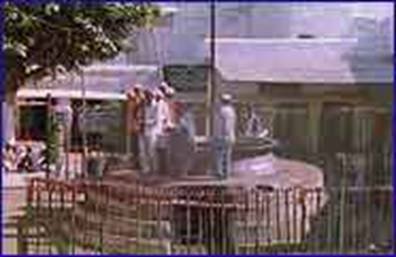
On either side of the second Buland Darwaza in front of Sahan Chirage (courtyard lamp), there are two huge Degs (cauldrons for cooking food) fixed into solid masonry in which a palatable mixture of rice, sugar, ghee (butter) and dried fruits is cooked for distribution to the public as tabarruk. The circumference at the edge of the larger cauldron is 10-1/4 feet. It cooks 70 mounds of rice, while the smaller Deg takes 28 mounds. One of them was presented by Akbar in 1567 A.D. The princes or the well-to-do pilgrims order these Degs to be cooked generally during the Urs period.

Badi Deg:Inside the Sahan-e-Chiragh and on the right side of Buland Darwaza is located Badi Deg. Emperor Akbar pledged to visit Ajmer Sharif on foot and presented a large cauldron if victorious in Chittaurgarh battle. So he kept his words after winning the battle. The circumference of the cauldron (Deg) is 12.5 yards and 125 mounds of rice can be cooked in it at a time. It was presented in 976 Hijri.
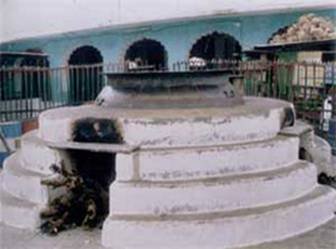
Chhoti Deg:It is located on the left side of Buland Darwaza inside Sahan-e-Chiragh. It was presented by Sultan Nooruddin Jahangir in 1013 Hijri. Eighty mounds of rice can be cooked in it at a time.
--------------------------------------------------------------------------------
THE MEHFIL KHANA
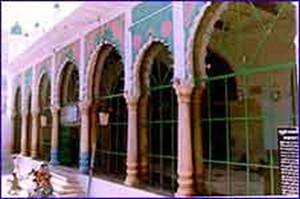
On the west of the Sahan Chirage stands the magnificent building of Samakhana or Mahfilkhana (auditorium with darbar hall) which was built by Nawab Bashir-ud-Dowla Sir Usmaan Jah of Hyderabad Deccan in 1888-91 A.D. This spacious hall is 46 feet square with a gallery of 14 feet running around it. It is used for 6 days only during the annual Urs for religious ‘Mahfils’ in which Qawwali is the chief item of programme commencing at 11 P.M. and ending with Fatiha (a religious ceremony) in the early hours of morning at 4 A.M. before Fazar Namaz (Prayer).
--------------------------------------------------------------------------------
THE MAUSOLEUM AND BEGAMI DAALAAN
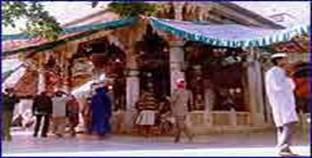
Overhanging the principal eastern to the Shrine or Mausoleum, there is a handsome porch known as Begami Daalaan which was built in 1643 AD by Princess Jahan Ara Begum, the favorite daughter of Emperor Shah Jahan.
The walls and the beautiful marble pillars of the Begami Daalaan were done in colorful gold in 1888 AD. Later on, the ceiling of this Daalaan was also embellished in gold with the money donated by a Muslim merchant of Bombay (Mumbai). This beautiful portico was used by the Begums or ladies of the Mughal haram during their frequent visits to the shrine.
--------------------------------------------------------------------------------
THE SHRINE:
There are two simultaneous entrances to the Shrine through the Begami Daalaan. The doors of both of them are mounted with heavy silver plate carved in ornamental details. The tomb is of white marble inlaid with pieces of precious stones and is daily bestrewed with sandal-paste and Itars (perfumes). It is always covered with very costly ‘ghilaafs’ (coverings made of velvet and silk) embroidered with pleasing gold and silver tracings.
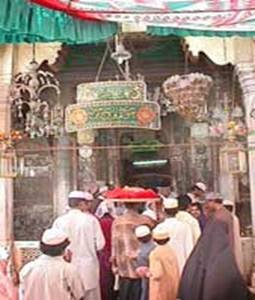
Over the tomb, there is a silver ‘chaparkhat’ (canopy) inlaid with pieces of mother-of-pearl presented by Emperor Jahangir. Between the four poles supporting this `chaparkhat’, there is silver `katehra’ (railing) with an arch towards the south. There is another outer silver katehra running around the tomb at a distance of about 2 feet. The devotees are led into this space to offer flowers and prayers over the tomb. The ceiling of the dome is covered by a costly velvet chatgiri. A peculiar kind of fascinating aroma prevails in the shrine which inspires the visitors with a spontaneous and irresistible urge for devotion and homage towards the asleep saint. As soon as one enters the interior of the shrine, he feels as if he is in the presence of some exalted soul or mighty spiritual king.
--------------------------------------------------------------------------------
JAMA MASJID
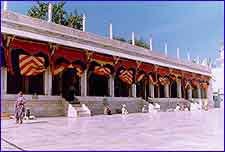
On the south wing of the Mehfil khana stands the Jama Masjid or Shah Jahani Mosque, which is a fine piece of Mughal architecture. All the 99 sacred names of Allah with 33 Quranic verses are beautifully inscribed in the mosque.
--------------------------------------------------------------------------------
BEGAMI DALAM:
This hall is located at the eastern main entrance of the Holy tomb and was erected by princess Jahan Ara, the daughter of Shahjahan. In this hall Khuddam sit regularly to perform Fatiha, Durood and Salaams and prayers and to guide pilgrims. The large courtyard around this hall used for Qawwali and Milad Sharif, is called Ahata-e-Noor.

---------------------------------------------------------------------------------
THE HOLY SCULPTURE (MAZAR SHARIF):
This is the center of the Holy Shrine where mortal remains of Hazrat Khwaja Moinuddin Chisty lie buried. The Mazar Sharif is made of precious stones and on top of it; there is a very precious jewel of immense value. The sculpture itself remains covered with gold studded Chadar (cloth sheet). There are two silver railing enclosures around the Mazar Sharif offered by Mughal rulers. On the gate of the enclosure, there is an inscription with a couplet written in golden letters which was presented by the Nizam of Hyderabad Deccan. The Jhajhri (small door) was presented by Swai Jai Singh II of Jaipur.
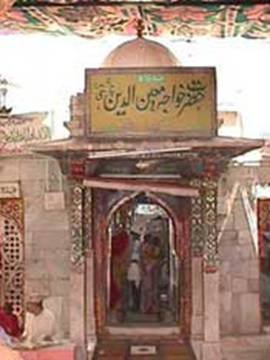
---------------------------------------------------------------------------------
MAZAR (TOMB) OF PRINCESS GAITI ARA:
Princess Gaiti Ara, the grand daughter of Emperor Shahjahan is also buried in the compound on the western side of the Shrine.
---------------------------------------------------------------------------------
MEETHE NEEM KI DARGAH:
On the way to Taragarh you will come across a Dargah of Meethe Neem Wale baba. The Neem of the Tree in this Dargah are sweet.
-------------------------------------------------------------------
MIRACLE ROCK:
Further on the same way you will come across a big white rock. On this rock you will see the Impressions of Khwaja Sahibs Chabuk and horse's knee. This stone was sent by Jaipal Jadugar who later accepted Islam to harm Khwaja Saheb.
---------------------------------------------------------------------------------
CHILAH QUTAB SAHIB (R.A.):
On the north-eastern side of Sada Bahar hill is located the Chillah of Hazrat Khwaja Qutubuddin Bakhtiyar Kaki (R.A.). It is the place where Hazrat engaged himself in prayers when in Ajmer.
---------------------------------------------------------------------------------
DAULAT BAGH:
Shahjahan build buildings of white marbles on the eastern bank of Anna Sagar. There is a very beautiful 'Baradari'. Amid these buildings and on the eastern side of it is located a beautiful green garden, named daulat Bagh. Its name has now been changed to Subhash Bagh
---------------------------------------------------------------------------------
CHILLA OF BABA FARID GANJ SHAKAR (R.A):

Hazrat Shaikh Fariduddin Ganj Shakar (R.A.) (Pak Pattan ob. 1265).
This is the place where Baba Farid Ganj Shakar performed Chillah. The place is under ground behind Masjid Sandal Khana. The actual place of Chillah is in the basement of the Masjid. Stairs lead down to the place. Its door are kept locked for the whole year and opened only for one day on 5th Muharram-ul-Haram. Pilgrims from far off places take the opportunity to have a look of the place.
|








